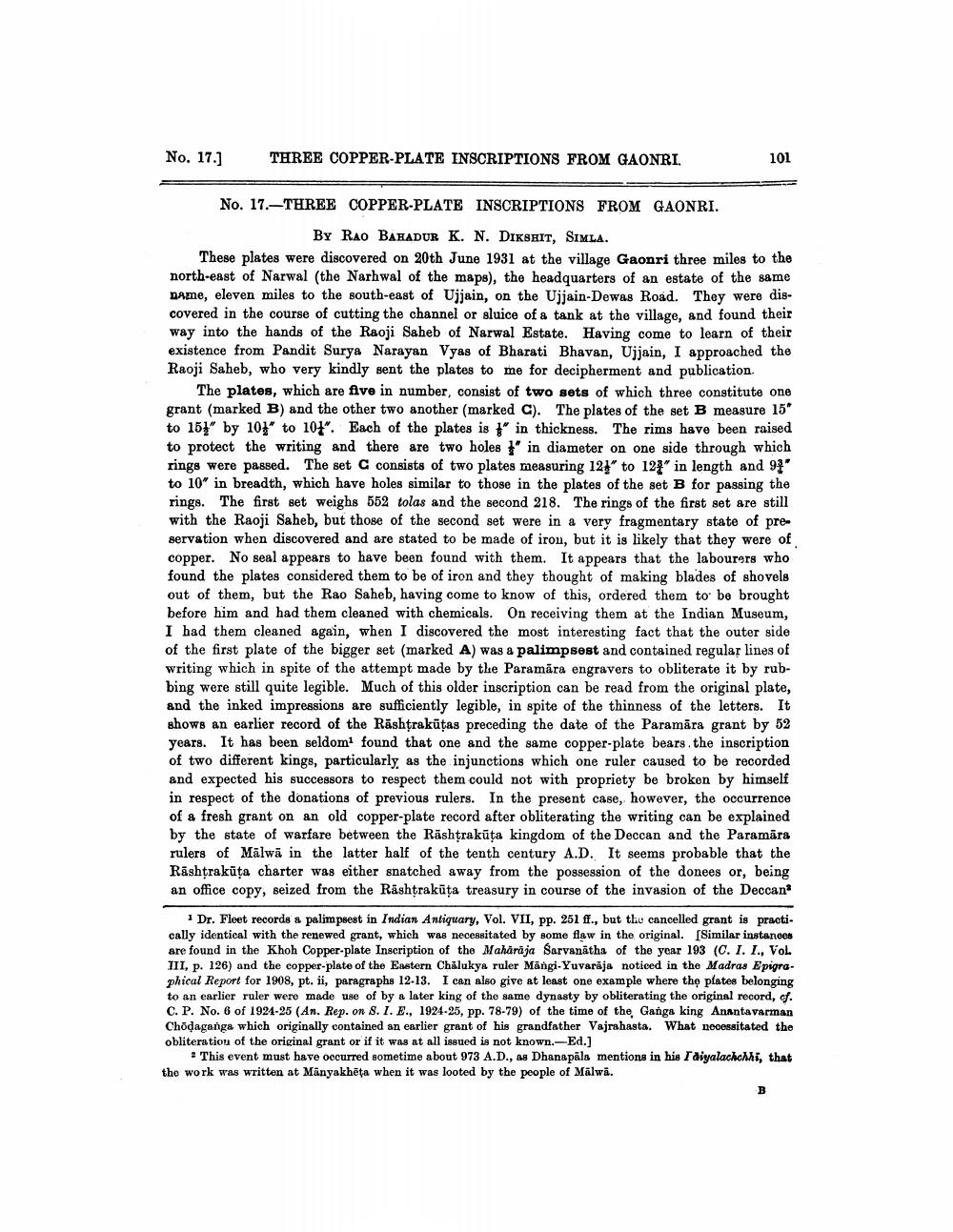________________
No. 17.]
THREE COPPER-PLATE INSCRIPTIONS FROM GAONRI.
101
No. 17.-THREE COPPER-PLATE INSCRIPTIONS FROM GAONRI.
BY RAO BAHADUR K. N. DIKSHIT, SIMLA. These plates were discovered on 20th June 1931 at the village Gaonri three miles to the north-east of Narwal (the Narhwal of the maps), the headquarters of an estate of the same Dame, eleven miles to the south-east of Ujjain, on the Ujjain-Dewas Road. They were discovered in the course of cutting the channel or sluice of a tank at the village, and found their way into the hands of the Raoji Saheb of Narwal Estate. Having come to learn of their existence from Pandit Surya Narayan Vyas of Bharati Bhavan, Ujjain, I approached the Raoji Saheb, who very kindly sent the plates to me for decipherment and publication.
The plates, which are five in number, consist of two sets of which three constitute one grant (marked B) and the other two another (marked C). The plates of the set B measure 15" to 151" by 101" to 101". Each of the plates is " in thickness. The rims have been raised to protect the writing and there are two holes in diameter on one side through which rings were passed. The set C consists of two plates measuring 121" to 12" in length and 91" to 10" in breadth, which have holes similar to those in the plates of the set B for passing the rings. The first set weighs 552 tolas and the second 218. The rings of the first set are still with the Raoji Saheb, but those of the second set were in a very fragmentary state of preservation when discovered and are stated to be made of irou, but it is likely that they were of copper. No seal appears to have been found with them. It appears that the labourers who found the plates considered them to be of iron and they thought of making blades of shovels out of them, but the Rao Saheb, having come to know of this, ordered them to be brought before him and had them cleaned with chemicals. On receiving them at the Indian Museum, I had them cleaned again, when I discovered the most interesting fact that the outer side of the first plate of the bigger set (marked A) was a palimpsest and contained regular lines of writing which in spite of the attempt made by the Paramāra engravers to obliterate it by rubbing were still quite legible. Much of this older inscription can be read from the original plate, and the inked impressions are sufficiently legible, in spite of the thinness of the letters. It shows an earlier record of the Rashtrakūtas preceding the date of the Paramāra grant by 52 years. It has been seldom found that one and the same copper-plate bears, the inscription of two different kings, particularly as the injunctions which one ruler caused to be recorded and expected his successors to respect them could not with propriety be broken by himself in respect of the donations of previous rulers. In the present case, however, the occurrence of a fresh grant on an old copper-plate record after obliterating the writing can be explained by the state of warfare between the Răshtrakūta kingdom of the Deccan and the Paramāra rulers of Mālwā in the latter half of the tenth century A.D. It seems probable that the Rāshtrakūta charter was either snatched away from the possession of the donees or, being an office copy, seized from the Rashtrakūta treasury in course of the invasion of the Deccan
1 Dr. Fleet records a palimpsest in Indian Antiquary, Vol. VII, pp. 251 ff., but the cancelled grant is practically identical with the renewed grant, which was necessitated by some flaw in the original. [Similar instances are found in the Khoh Copper-plate Inscription of the Maharaja Sarvanātha of the year 193 (C. I. I., VOL. III, p. 126) and the copper-plate of the Eastern Chalukya ruler Māngi-Yuvarāja noticed in the Madras Epigraphical Report for 1908, pt. ii, paragraphs 12-13. I can also give at least one example where thọ plates belonging to an earlier ruler were made use of by a later king of the same dynasty by obliterating the original record, cf. C. P. No. 6 of 1921-25 (An. Rep. on 8. I. E., 1924-25, PP. 78-79) of the time of the Ganga king Anantavarman Chodaganga which originally contained an earlier grant of his grandfather Vajrahasta. What necessitated the obliteratiou of the original grant or if it was at all issued is not known.-Ed.]
: This event must have occurred sometime about 973 A.D., as Dhanapāla mentions in his raiyalachchhi, that the work was written at Manyakhēta when it was looted by the people of Malwa.




